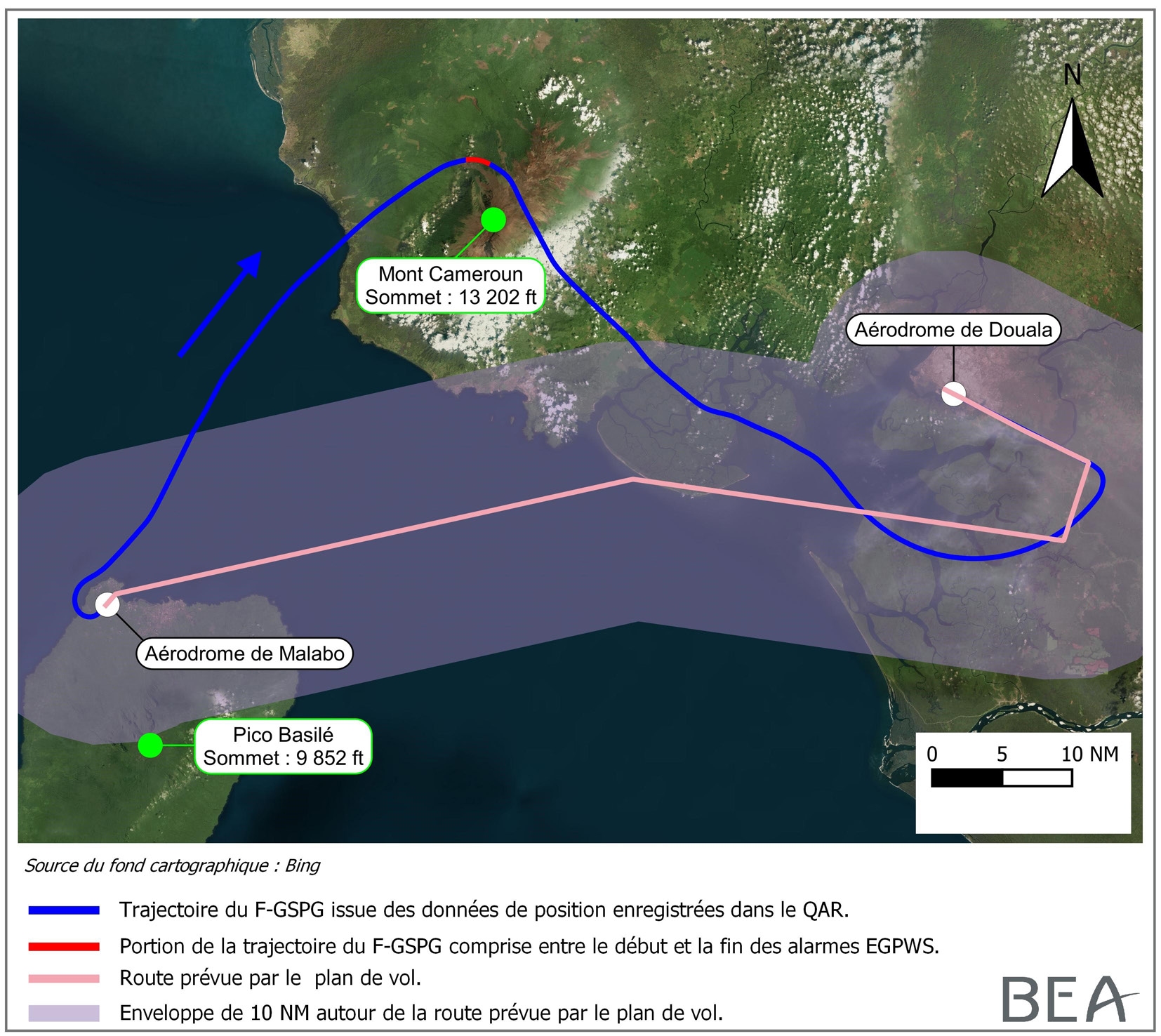
ASN Wikibase Occurrence # 266787
This information is added by users of ASN. Neither ASN nor the Flight Safety Foundation are responsible for the completeness or correctness of this information.
If you feel this information is incomplete or incorrect, you can submit corrected information.
| Date: | Saturday 2 May 2015 |
| Time: | 21:14 LT |
| Type: |  Boeing 777-228ER |
| Owner/operator: | Air France |
| Registration: | F-GSPG |
| MSN: | 27609/195 |
| Year of manufacture: | 1999 |
| Fatalities: | Fatalities: 0 / Occupants: 37 |
| Aircraft damage: | None |
| Category: | Serious incident |
| Location: | Mont Cameroun -
 Cameroon Cameroon
|
| Phase: | En route |
| Nature: | Passenger - Scheduled |
| Departure airport: | FGSL |
| FKKD | |
| Investigating agency: | BEA |
| Confidence Rating: |
An Air France Boeing 777-200ER received a terrain warning while maneuvering around poor weather over mountainous terrain near Mont Cameroun.
During the preparation of the flight, threats related to the terrain on departure from Malabo, the weather conditions and numerous ATC communications were identified and led the captain to ask the reinforcement co-pilot for special attention during the flight.
After the briefing and before departure, the crew was attentive to the weather development and sought updated information on several occasions in order to decide the best time to depart. The information according to which two planes had been able to land led the crew to begin the flight.
Shortly after take-off, the crew turned right to join the flight plan route, taking care to turn so as to avoid the terrain of Malabo. The two pilots had positioned their navigation screens (ND) in Weather mode.
The avoidance of thunderstorm masses led the crew to depart significantly from the route provided by the flight plan. Although the proximity of Mount Cameroon was mentioned during the briefing, the risk of dangerous approach with this terrain was not identified.
The crew managed their trajectory with the preoccupations of avoiding cloud masses and communications with air traffic controllers. It thus moved away from the route provided by the flight plan and approached Mount Cameroon located to the north of the planned route.
The co-pilot (Pilot Flying) temporarily switched his ND to Terrain mode. However, this action was carried out for too short a time (five to six secons) for the aircraft's radar to construct a complete picture of the situation. This led the PF to think that Mount Cameroon was in front of them.
When the captain (Pilot Monitoring) a few moments later suggested turning right to join the start of the DME arc, he thought they were south southwest of Mount Cameroon. This misrepresentation was favored by the presentation of the paper chart used to navigate.
The PF still doubted their exact position and the nature of the echo on the right, but did not verbalize it. After some hesitation, he followed the suggestion of the captain (PM). This doubt was manifested by a slow turning by the PF.
About thirty seconds after the start of the turn, the EGPWS alerts "TERRAIN AHEAD" then "PULL UP" sounded and the two NDs switched to mode Terrain.
The triggering of these alerts enabled the PF to become aware of the presence of Mount Cameroon. The reaction to the alarm was swift. While carrying out the emergency maneuver, the PF initially maintained the bank. During the maneuver, concerned about the risk of collision with other traffic, the Captain (PM) observed the external environment and asked the PF to stop the climb at FL110 then to FL120 while the summit of the Mont Cameroon is above these altitudes. This concern of the captain was motivated by the occurrence of a mid-air collision with other traffic during a simulator session a few months before the incident.
The air traffic controller, who was particularly involved in preventing collisions between aircraft, was not informed of the maneuver and of the departure from the assigned altitude.
The climb was interrupted at FL130, below the safety altitude, and the flight continued without further incident until landing.
Contributing factors:
- The crew's preoccupation with avoiding storm masses and reporting to ATC, to the detriment of monitoring the trajectory. The crew deviated significantly from the flight plan, which rendered the safety altitudes mentioned in the flight plan null and void.
- The simultaneous use of both radars in Weather mode.
- The representation of the Malabo aerodrome on a map that was not to scale, which did not facilitate the identification of the position of the planned route in relation to the terrain.
- The lack of display of MORA (Minimum off-route altitude) or grid mora safety altitudes on the ND of the Boeing 777.
- The absence of a study of the cruise phase during the risk assessment by the operator prior to the opening of the route between Douala and Malabo, leading to the failure to identify any risk of dangerous approach to the terrain during cruise.
The activation of EGPWS alerts and the immediate reaction of the crew prevented the collision with the terrain.
Accident investigation:
 |
|
Sources:
https://bea.aero/en/investigation-reports/notified-events/detail/serious-incident-to-the-boeing-777-228er-registered-f-gspg-operated-by-air-france-occured-on-may-2-2015-near-cameroon-mountain/
Images:

Revision history:
| Date/time | Contributor | Updates |
|---|---|---|
| 16-Aug-2021 08:45 | harro | Added |
| 16-Aug-2021 08:52 | harro | Updated [Time, Operator, Total occupants, Narrative, Photo] |
| 21-Apr-2022 07:56 | harro | Updated [Accident report] |
Corrections or additions? ... Edit this accident description
The Aviation Safety Network is an exclusive service provided by:


 ©2024 Flight Safety Foundation
©2024 Flight Safety Foundation